Junping Zhang
UniAPO: Unified Multimodal Automated Prompt Optimization
Aug 25, 2025
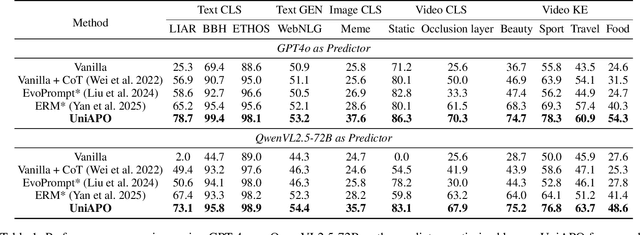
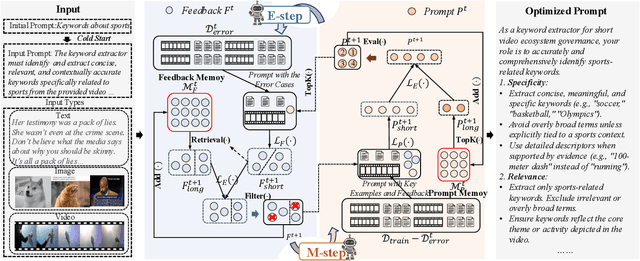
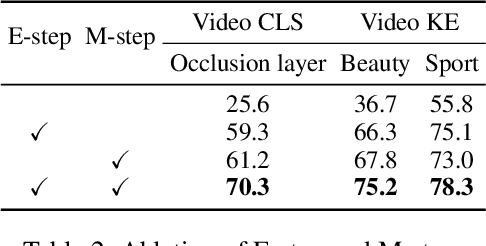
Abstract:Prompting is fundamental to unlocking the full potential of large language models. To automate and enhance this process, automatic prompt optimization (APO) has been developed, demonstrating effectiveness primarily in text-only input scenarios. However, extending existing APO methods to multimodal tasks, such as video-language generation introduces two core challenges: (i) visual token inflation, where long visual token sequences restrict context capacity and result in insufficient feedback signals; (ii) a lack of process-level supervision, as existing methods focus on outcome-level supervision and overlook intermediate supervision, limiting prompt optimization. We present UniAPO: Unified Multimodal Automated Prompt Optimization, the first framework tailored for multimodal APO. UniAPO adopts an EM-inspired optimization process that decouples feedback modeling and prompt refinement, making the optimization more stable and goal-driven. To further address the aforementioned challenges, we introduce a short-long term memory mechanism: historical feedback mitigates context limitations, while historical prompts provide directional guidance for effective prompt optimization. UniAPO achieves consistent gains across text, image, and video benchmarks, establishing a unified framework for efficient and transferable prompt optimization.
FoundDiff: Foundational Diffusion Model for Generalizable Low-Dose CT Denoising
Aug 24, 2025Abstract:Low-dose computed tomography (CT) denoising is crucial for reduced radiation exposure while ensuring diagnostically acceptable image quality. Despite significant advancements driven by deep learning (DL) in recent years, existing DL-based methods, typically trained on a specific dose level and anatomical region, struggle to handle diverse noise characteristics and anatomical heterogeneity during varied scanning conditions, limiting their generalizability and robustness in clinical scenarios. In this paper, we propose FoundDiff, a foundational diffusion model for unified and generalizable LDCT denoising across various dose levels and anatomical regions. FoundDiff employs a two-stage strategy: (i) dose-anatomy perception and (ii) adaptive denoising. First, we develop a dose- and anatomy-aware contrastive language image pre-training model (DA-CLIP) to achieve robust dose and anatomy perception by leveraging specialized contrastive learning strategies to learn continuous representations that quantify ordinal dose variations and identify salient anatomical regions. Second, we design a dose- and anatomy-aware diffusion model (DA-Diff) to perform adaptive and generalizable denoising by synergistically integrating the learned dose and anatomy embeddings from DACLIP into diffusion process via a novel dose and anatomy conditional block (DACB) based on Mamba. Extensive experiments on two public LDCT datasets encompassing eight dose levels and three anatomical regions demonstrate superior denoising performance of FoundDiff over existing state-of-the-art methods and the remarkable generalization to unseen dose levels. The codes and models are available at https://github.com/hao1635/FoundDiff.
PROTOCOL: Partial Optimal Transport-enhanced Contrastive Learning for Imbalanced Multi-view Clustering
Jun 14, 2025Abstract:While contrastive multi-view clustering has achieved remarkable success, it implicitly assumes balanced class distribution. However, real-world multi-view data primarily exhibits class imbalance distribution. Consequently, existing methods suffer performance degradation due to their inability to perceive and model such imbalance. To address this challenge, we present the first systematic study of imbalanced multi-view clustering, focusing on two fundamental problems: i. perceiving class imbalance distribution, and ii. mitigating representation degradation of minority samples. We propose PROTOCOL, a novel PaRtial Optimal TranspOrt-enhanced COntrastive Learning framework for imbalanced multi-view clustering. First, for class imbalance perception, we map multi-view features into a consensus space and reformulate the imbalanced clustering as a partial optimal transport (POT) problem, augmented with progressive mass constraints and weighted KL divergence for class distributions. Second, we develop a POT-enhanced class-rebalanced contrastive learning at both feature and class levels, incorporating logit adjustment and class-sensitive learning to enhance minority sample representations. Extensive experiments demonstrate that PROTOCOL significantly improves clustering performance on imbalanced multi-view data, filling a critical research gap in this field.
Towards Understanding the Nature of Attention with Low-Rank Sparse Decomposition
Apr 29, 2025Abstract:We propose Low-Rank Sparse Attention (Lorsa), a sparse replacement model of Transformer attention layers to disentangle original Multi Head Self Attention (MHSA) into individually comprehensible components. Lorsa is designed to address the challenge of attention superposition to understand attention-mediated interaction between features in different token positions. We show that Lorsa heads find cleaner and finer-grained versions of previously discovered MHSA behaviors like induction heads, successor heads and attention sink behavior (i.e., heavily attending to the first token). Lorsa and Sparse Autoencoder (SAE) are both sparse dictionary learning methods applied to different Transformer components, and lead to consistent findings in many ways. For instance, we discover a comprehensive family of arithmetic-specific Lorsa heads, each corresponding to an atomic operation in Llama-3.1-8B. Automated interpretability analysis indicates that Lorsa achieves parity with SAE in interpretability while Lorsa exhibits superior circuit discovery properties, especially for features computed collectively by multiple MHSA heads. We also conduct extensive experiments on architectural design ablation, Lorsa scaling law and error analysis.
A2DO: Adaptive Anti-Degradation Odometry with Deep Multi-Sensor Fusion for Autonomous Navigation
Feb 28, 2025Abstract:Accurate localization is essential for the safe and effective navigation of autonomous vehicles, and Simultaneous Localization and Mapping (SLAM) is a cornerstone technology in this context. However, The performance of the SLAM system can deteriorate under challenging conditions such as low light, adverse weather, or obstructions due to sensor degradation. We present A2DO, a novel end-to-end multi-sensor fusion odometry system that enhances robustness in these scenarios through deep neural networks. A2DO integrates LiDAR and visual data, employing a multi-layer, multi-scale feature encoding module augmented by an attention mechanism to mitigate sensor degradation dynamically. The system is pre-trained extensively on simulated datasets covering a broad range of degradation scenarios and fine-tuned on a curated set of real-world data, ensuring robust adaptation to complex scenarios. Our experiments demonstrate that A2DO maintains superior localization accuracy and robustness across various degradation conditions, showcasing its potential for practical implementation in autonomous vehicle systems.
Radiologist-in-the-Loop Self-Training for Generalizable CT Metal Artifact Reduction
Jan 26, 2025



Abstract:Metal artifacts in computed tomography (CT) images can significantly degrade image quality and impede accurate diagnosis. Supervised metal artifact reduction (MAR) methods, trained using simulated datasets, often struggle to perform well on real clinical CT images due to a substantial domain gap. Although state-of-the-art semi-supervised methods use pseudo ground-truths generated by a prior network to mitigate this issue, their reliance on a fixed prior limits both the quality and quantity of these pseudo ground-truths, introducing confirmation bias and reducing clinical applicability. To address these limitations, we propose a novel Radiologist-In-the-loop SElf-training framework for MAR, termed RISE-MAR, which can integrate radiologists' feedback into the semi-supervised learning process, progressively improving the quality and quantity of pseudo ground-truths for enhanced generalization on real clinical CT images. For quality assurance, we introduce a clinical quality assessor model that emulates radiologist evaluations, effectively selecting high-quality pseudo ground-truths for semi-supervised training. For quantity assurance, our self-training framework iteratively generates additional high-quality pseudo ground-truths, expanding the clinical dataset and further improving model generalization. Extensive experimental results on multiple clinical datasets demonstrate the superior generalization performance of our RISE-MAR over state-of-the-art methods, advancing the development of MAR models for practical application. Code is available at https://github.com/Masaaki-75/rise-mar.
DepMamba: Progressive Fusion Mamba for Multimodal Depression Detection
Sep 24, 2024



Abstract:Depression is a common mental disorder that affects millions of people worldwide. Although promising, current multimodal methods hinge on aligned or aggregated multimodal fusion, suffering two significant limitations: (i) inefficient long-range temporal modeling, and (ii) sub-optimal multimodal fusion between intermodal fusion and intramodal processing. In this paper, we propose an audio-visual progressive fusion Mamba for multimodal depression detection, termed DepMamba. DepMamba features two core designs: hierarchical contextual modeling and progressive multimodal fusion. On the one hand, hierarchical modeling introduces convolution neural networks and Mamba to extract the local-to-global features within long-range sequences. On the other hand, the progressive fusion first presents a multimodal collaborative State Space Model (SSM) extracting intermodal and intramodal information for each modality, and then utilizes a multimodal enhanced SSM for modality cohesion. Extensive experimental results on two large-scale depression datasets demonstrate the superior performance of our DepMamba over existing state-of-the-art methods. Code is available at https://github.com/Jiaxin-Ye/DepMamba.
HOPE: Hybrid-granularity Ordinal Prototype Learning for Progression Prediction of Mild Cognitive Impairment
Jan 19, 2024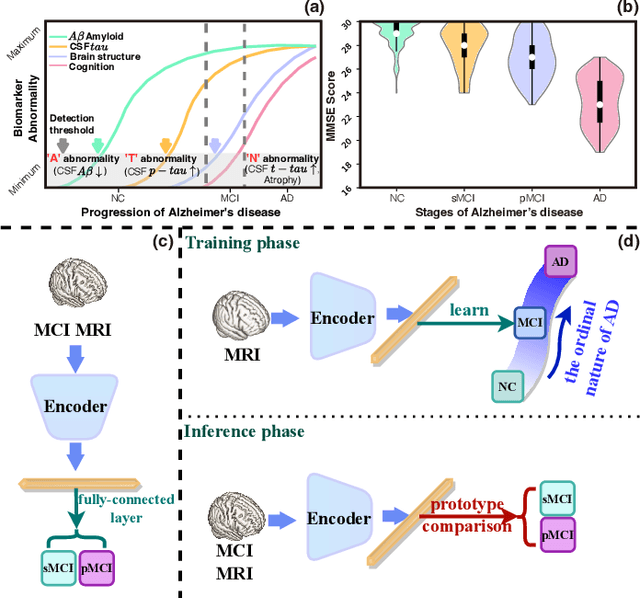
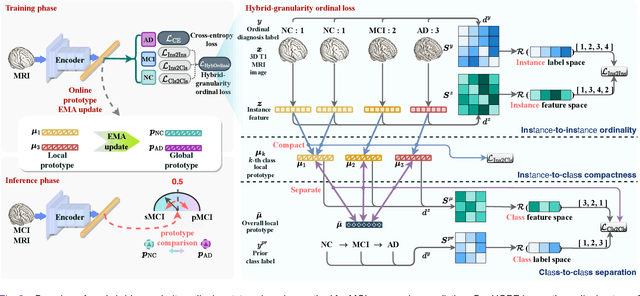
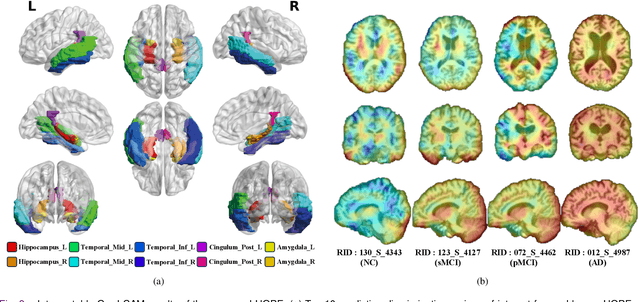

Abstract:Mild cognitive impairment (MCI) is often at high risk of progression to Alzheimer's disease (AD). Existing works to identify the progressive MCI (pMCI) typically require MCI subtype labels, pMCI vs. stable MCI (sMCI), determined by whether or not an MCI patient will progress to AD after a long follow-up. However, prospectively acquiring MCI subtype data is time-consuming and resource-intensive; the resultant small datasets could lead to severe overfitting and difficulty in extracting discriminative information. Inspired by that various longitudinal biomarkers and cognitive measurements present an ordinal pathway on AD progression, we propose a novel Hybrid-granularity Ordinal PrototypE learning (HOPE) method to characterize AD ordinal progression for MCI progression prediction. First, HOPE learns an ordinal metric space that enables progression prediction by prototype comparison. Second, HOPE leverages a novel hybrid-granularity ordinal loss to learn the ordinal nature of AD via effectively integrating instance-to-instance ordinality, instance-to-class compactness, and class-to-class separation. Third, to make the prototype learning more stable, HOPE employs an exponential moving average strategy to learn the global prototypes of NC and AD dynamically. Experimental results on the internal ADNI and the external NACC datasets demonstrate the superiority of the proposed HOPE over existing state-of-the-art methods as well as its interpretability. Source code is made available at https://github.com/thibault-wch/HOPE-for-mild-cognitive-impairment.
* IEEE Journal of Biomedical and Health Informatics, 2024
Universal Incomplete-View CT Reconstruction with Prompted Contextual Transformer
Dec 13, 2023Abstract:Despite the reduced radiation dose, suitability for objects with physical constraints, and accelerated scanning procedure, incomplete-view computed tomography (CT) images suffer from severe artifacts, hampering their value for clinical diagnosis. The incomplete-view CT can be divided into two scenarios depending on the sampling of projection, sparse-view CT and limited-angle CT, each encompassing various settings for different clinical requirements. Existing methods tackle with these settings separately and individually due to their significantly different artifact patterns; this, however, gives rise to high computational and storage costs, hindering its flexible adaptation to new settings. To address this challenge, we present the first-of-its-kind all-in-one incomplete-view CT reconstruction model with PROmpted Contextual Transformer, termed ProCT. More specifically, we first devise the projection view-aware prompting to provide setting-discriminative information, enabling a single model to handle diverse incomplete-view CT settings. Then, we propose artifact-aware contextual learning to provide the contextual guidance of image pairs from either CT phantom or publicly available datasets, making ProCT capable of accurately removing the complex artifacts from the incomplete-view CT images. Extensive experiments demonstrate that ProCT can achieve superior performance on a wide range of incomplete-view CT settings using a single model. Remarkably, our model with only image-domain information surpasses the state-of-the-art dual-domain methods that require the access to raw data. The code is available at: https://github.com/Masaaki-75/proct
Prompt-In-Prompt Learning for Universal Image Restoration
Dec 08, 2023



Abstract:Image restoration, which aims to retrieve and enhance degraded images, is fundamental across a wide range of applications. While conventional deep learning approaches have notably improved the image quality across various tasks, they still suffer from (i) the high storage cost needed for various task-specific models and (ii) the lack of interactivity and flexibility, hindering their wider application. Drawing inspiration from the pronounced success of prompts in both linguistic and visual domains, we propose novel Prompt-In-Prompt learning for universal image restoration, named PIP. First, we present two novel prompts, a degradation-aware prompt to encode high-level degradation knowledge and a basic restoration prompt to provide essential low-level information. Second, we devise a novel prompt-to-prompt interaction module to fuse these two prompts into a universal restoration prompt. Third, we introduce a selective prompt-to-feature interaction module to modulate the degradation-related feature. By doing so, the resultant PIP works as a plug-and-play module to enhance existing restoration models for universal image restoration. Extensive experimental results demonstrate the superior performance of PIP on multiple restoration tasks, including image denoising, deraining, dehazing, deblurring, and low-light enhancement. Remarkably, PIP is interpretable, flexible, efficient, and easy-to-use, showing promising potential for real-world applications. The code is available at https://github.com/longzilicart/pip_universal.
 Add to Chrome
Add to Chrome Add to Firefox
Add to Firefox Add to Edge
Add to Edge